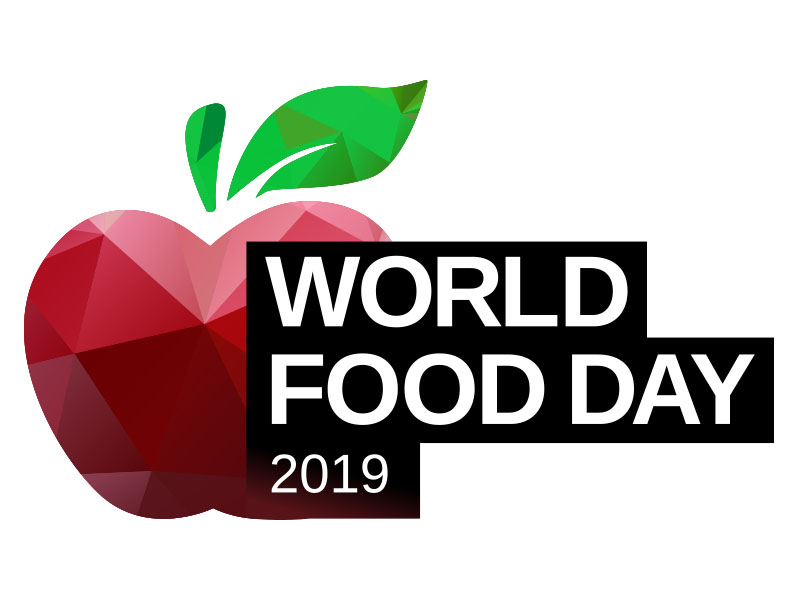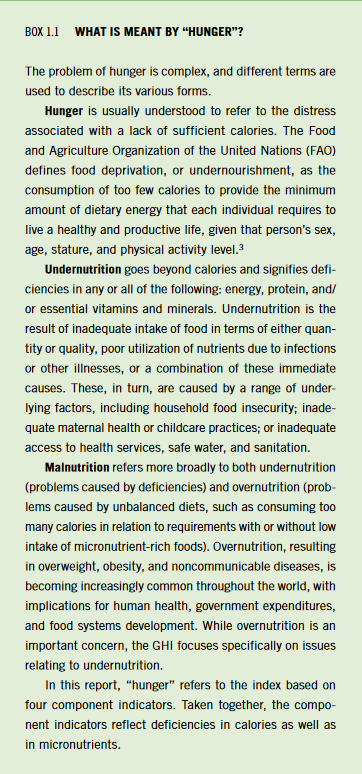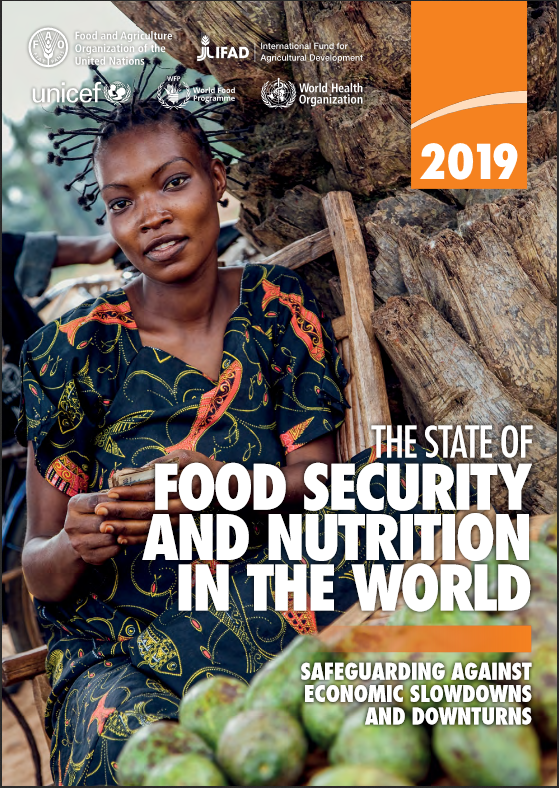As part of the World Food Day series, Colm Regan summarises 5 key takeaways from two reports – the Global Hunger Index 2019 and the State of Food Security and Nutrition in the World 2019.
This series has been developed in conjunction with Scoilnet, Self Help Africa, Concern Worldwide and developmenteducation.ie

Report 1: beginning in 2006, the non-governmental organisations Concern Worldwide (Ireland) and Welthungerhilfe (Germany) have jointly researched and published the annual Global Hunger Index. The report tracks the state of hunger world-wide and highlights key issues as well as places where action to address hunger is most urgently needed.
Report 2: each year the UN Food and Agriculture Organisation publishes the State of Food Security and Nutrition in the World Report and along with the the Index offers you most of what you need to know on this important topic.
1. An estimated 26.4% or 2 billion people experience ongoing hunger today
Overall, global hunger is now moving from what is described as ‘serious’ to ‘moderate’; the progress made to date (down by 28% since 2000) is impressive and offers real hope for the future on a number of levels.
Despite this, the number of undernourished people rose from 785 million in 2015 to 822 million in 2018. Taking a broader look at the picture, about 17.2% of world population (1.3 billion people) experience food insecurity at ‘moderate levels’ meaning they do not have regular access to nutritious and sufficient food with all that this implies in terms of human well-being. When added to the numbers experiencing ‘severe levels of food insecurity’, an estimated 26.4% or 2 billion people experience ongoing hunger today.
About 151 million children are stunted and 51 million children are wasted across the globe. The progress made in recent decades is now being threatened by conflict, climate change, poor governance, and many other challenges.
The agenda of the Sustainable Development Goals agreed in 2015 committed both developed and developing countries to achieving zero hunger by 2030. We are not on track to meet that goal and if the current patterns and trends continue an estimated 50 countries will fail to achieve ‘low hunger’ levels by 2030.
While the progress made to date illustrates what can be done, the root causes and the complex realities of hunger are not being adequately tackled. In 2015 (through the Sustainable Development Goals) the world’s countries committed to achieving zero hunger by 2030.
We are not on track to meet that goal and if current trends continue an estimated 50 countries will fail to achieve ‘low hunger’ by 2030.
2. Globally, 7.3 percent (49.5 million) children under five years of age are wasted, two-thirds of whom live in Asia
Hunger varies enormously by region with the most serious levels occurring in South Asia and sub-Saharan Africa. This contrasts sharply with levels in East and Southeast Asia, the Near East and North Africa, Latin America and the Caribbean, Eastern Europe and the Commonwealth of Independent States with ‘moderate’ levels of hunger.
Mixed news on what has been achieved and on what requires urgent action. Since 2000, the rate of stunting in South Asia has fallen from approximately half of all children to just over a third (still the highest regional child stunting rate worldwide). Tragically, South Asia’s child wasting rate has slightly increased since 2000.
Sub-Saharan Africa has the highest rates of undernourishment and child mortality. Conflict and poor climatic conditions have made under-nourishment there worse. The impact of conflict on child mortality is starkly evident: the 10 countries with the world’s highest under-five mortality rates are all in Africa south of the Sahara, and 7 of these are considered fragile and conflict prone states.
The scale and severity of hunger is evidenced in the reality that six countries suffer from levels of hunger that are ‘alarming’ with one country – the Central African Republic registering ‘extremely alarming’ levels. The 6 countries with alarming levels of hunger are Chad, Haiti, Madagascar, Sierra Leone, Yemen, and Zambia. Forty-five countries out of 119 countries that were ranked have ‘serious’ levels of hunger.
3. Short- and medium-term policies need to focus on pro-poor and inclusive change, something that is not possible by focusing on economic growth alone
Detailed case studies of Bangladesh and Ethiopia highlight those strategies and interventions that appear to be most effective in tackling hunger. The studies suggest that a combination of macro- and micro- interventions are most effective.
Central to challenging hunger is rising household wealth linked directly to ‘pro-poor economic growth’ (as distinct from ‘trickle down’ models of growth), a focus on the education of parents as well as on health, sanitation and on the well-being and status of women.
Micro level interventions such as the targeting of the ‘Ultra Poor’ (those who eat below 80% of their energy requirements despite spending at least 80% of their income on food – the majority tend to be landless rural women) have been successful. This strategy now used in over 20 countries focuses particularly on an income-generating asset (e.g. livestock or poultry), business development training, enterprise management assistance, a subsistence allowance, health services and a social support network.
Direct focus on the nutritional status of women is key for both the women themselves and for their children. Women with low levels of education, empowerment and decision-making power are about 50% more likely to experience undernutrition than other women. Prioritising the needs and vulnerabilities of women and girls, ensuring they have equal access to assets, services, productive and financial resources as well as income-generating opportunities remains vital. Addressing other issues such as gender-based violence and exploitation have also been highlighted.
4. The evidence indicates that in countries with greater levels of inequality, economic crises and downturns have greater negative effect on food and nutrition security
Growing inequality directly affects hunger. Income inequality is rising in nearly half of all countries worldwide including many low- and middle-income countries. Several countries in Africa and Asia have seen large increases in income inequality in the past 15 years. Such inequality increases the likelihood of severe food insecurity. The prevalence of severe food insecurity is almost three times higher in countries with high income inequality (at 21%) compared with countries with low income inequality (at 7%).
The greater the inequality in the distribution of resources such as land, water, capital, finance, education and health, the more difficult it is for the poor to participate in and benefit from economic growth. In turn this slows the progress in reducing food insecurity and malnutrition. Socially excluded and marginalised groups are likely to be hit particularly hard by economic downturns.
5. More ambitious actions are required to reduce the risks of climate change (mitigation) and to cope with its impacts (adaptation) on food and nutrition security
Climate change has direct and indirect negative impacts on food security and hunger through changes in food production and availability, access, quality, utilisation, and stability of food systems. Food production is likely to fall in response to higher temperatures, water scarcity, greater CO2 concentrations in the atmosphere, and extreme events such as heat waves, droughts, and floods. Already, yields of major food crops such as maize and wheat are declining owing to extreme events, epidemics of plant diseases, and declining water resources.
A changing climate may worsen food losses in a global food system in which massive amounts of food are already lost or wasted. Given that the current food system contributes between 21% and 37% of total net anthropogenic emissions, these losses exacerbate climate change without contributing to improved food security or nutrition.
Climate change can contribute to conflict, especially in vulnerable and food-insecure regions, creating a double vulnerability for communities, which are pushed beyond their ability to cope. The combined impact of conflict and climate change destroys livelihoods, drives displacement, widens economic and gender inequalities, and undermines long-term recovery and sustainable development.
‘That is the greatest injustice of climate change – that those who bear the least responsibility for climate change are the ones who will suffer the most. This year’s Global Hunger Index provides a timely illustration of how climate breakdown disrupts food systems, jeopardizing one of the most fundamental rights we all share as human beings – the right to adequate and sufficient food.’
Mary Robinson, Preface, Global Hunger Index 2019
Note:
The Global Hunger Index measures hunger in 4 dimensions:
- Undernourishment – the share of the population that is under-nourished (that is, whose caloric intake is insufficient)
- Child Wasting – the share of children under the age of five who are wasted (that is, who have low weight for their height, reflecting acute undernutrition)
- Child Stunting – the share of children under the age of five who are stunted (that is, who have low height for their age, reflecting chronic undernutrition)
- Child Mortality – the mortality rate of children under the age of five (in part, a reflection of the fatal mix of inadequate nutrition and unhealthy environments).
This panel (from the GHI) offers a quick discussion of the concept of hunger, undernutrition and malnutrition.
The data used are sourced from a range of international and national organisations such as the Food and Agriculture Organisation of the United Nations (FAO), the UN Inter-agency Group for Child Mortality Estimation, UNICEF, the World Health Organisation, and the World Bank etc.



